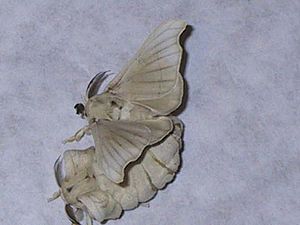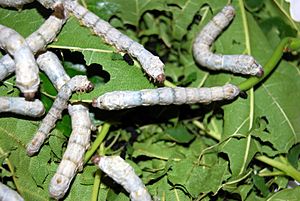Silkworm facts for kids
Quick facts for kids Silk Worm |
|
|---|---|
 |
|
| Paired male (above) and female (below) | |
 |
|
| Fifth instar silkworm larvae
Video: Metamorphosis/Life cycle of the Silkworm |
|
| Conservation status | |
| Scientific classification | |
| Kingdom: | |
| Phylum: | |
| Class: | |
| Order: | |
| Family: | |
| Genus: |
Bombyx
|
| Species: |
B. mori
|
| Binomial name | |
| Bombyx mori |
|
The silkworm is the caterpillar of a special moth called the Bombyx mori. This moth is super important because it helps us make silk. People have been making silk for at least 5000 years, starting in China.
Silkworms eat mulberry leaves. They originally came from northern China. Today, these silkworms depend entirely on humans. They can no longer live in the wild on their own.
The silkworm we use today (B. mori) can still breed with its wild cousin, the Bombyx mandarina. Sometimes, they even have baby moths that are a mix of both!
Contents
Silkworm Life Cycle
Egg Stage
A female silkworm moth lays about 300 tiny eggs at one time. She usually lays them on mulberry leaves. The eggs are sticky, so they stay attached to the leaves. After laying her eggs, the female moth sadly dies because she doesn't eat anything as an adult.
People often keep the eggs in a cool place. This helps store them for a long time. When conditions are just right, like a temperature between 18 and 25 degrees Celsius, the eggs hatch. This usually happens in about two weeks.
Silk Production
The silkworm caterpillar spins a special case around itself called a cocoon. This cocoon is made from one long, continuous thread of raw silk. This thread can be anywhere from 300 to 900 meters long! That's like 1000 to 3000 feet! The silk fibers are very, very thin.
To make just one pound of silk, you need a lot of cocoons. It takes about 2,000 to 5,000 cocoons to get that much silk.
If the silkworm were allowed to grow up and fly out of its cocoon, it would make a hole. This hole would break the long silk thread, ruining it for silk making. So, to get the silk, the cocoons are put into boiling water. This process helps to kill the silkworms inside. It also makes it easier to unroll the silk thread from the cocoon. Sometimes, the silkworms themselves are even eaten as food!
Adult Moths
Once they become adult moths, silkworms cannot fly. They have wings that are about 2 inches wide. Their bodies are white and a bit fuzzy. Both male and female moths look very similar. Adult silkworms have tiny mouths and do not eat at all.
Legends of Silk
The Chinese Discovery
In China, there's an old story about how silk was first found. The legend says that Leizu, the wife of the Yellow Emperor, discovered silk around 2696 BC. The story goes that she was drinking tea under a tree. A silkworm cocoon fell into her cup!
When she picked it out, the silk thread started to unwrap around her finger. She felt something warm and soft. As the thread kept unwinding, she saw a small cocoon. She quickly realized that this cocoon was the source of the beautiful silk. Leizu then taught her people how to make silk, and it became a very important part of Chinese culture. There are many other cool legends about silkworms too!
Silk Spreads West
For a long time, the Chinese kept the secret of silk making to themselves. They didn't want anyone else to know how to do it. But the secret eventually got out!
It's said that a Chinese princess helped spread silk to Khotan. Khotan was an oasis city on the edge of the Taklamakan Desert. This was one of the first places outside of China to start growing silkworms. The princess supposedly hid silkworm eggs in her hair to smuggle them out of China. After this, the knowledge of how to make silk slowly traveled to Western Asia and then to Europe.
Silk in Japan
The Japanese also loved silk and started making it very early on. A history book from the 3rd century, called Records of the Three Kingdoms, says that Japan was already sending silk to a Chinese kingdom called Wei in the 2nd century. That's a long time ago! It takes about 5000 silkworms to make enough silk for just one traditional Japanese kimono.
Related pages
- Sericulture - This is the name for raising silkworms to produce silk fibers. It's also called "silk farming."
Images for kids
-
A study of an egg of a silkworm from Hooke's Micrographia, 1665
-
1679 study of the silkworm metamorphosis by Maria Sibylla Merian, it depicts the fruit and leaves of a mulberry tree and the eggs and larvae of the silkworm moth.
-
Gold silkworm, Han dynasty
See also
 In Spanish: Gusano o mariposa de seda para niños
In Spanish: Gusano o mariposa de seda para niños










